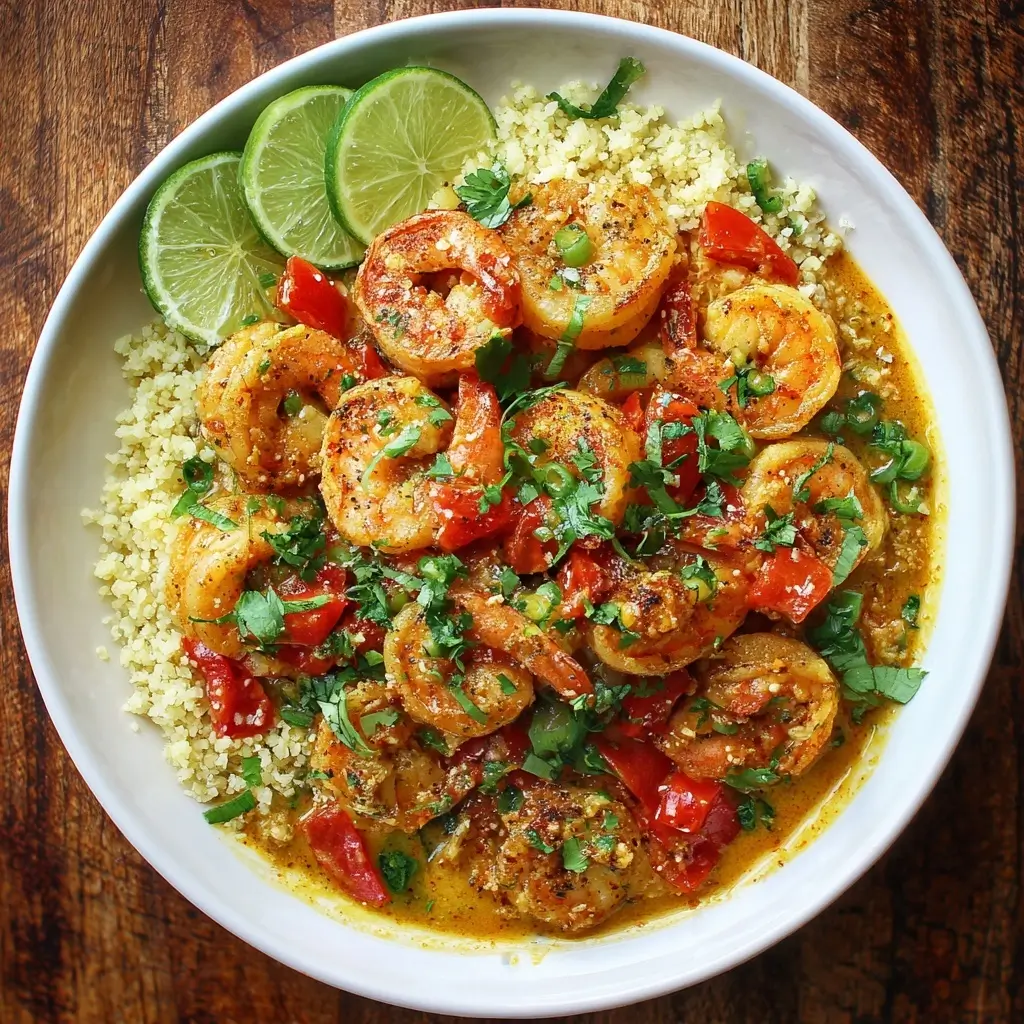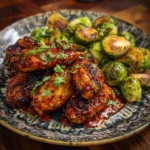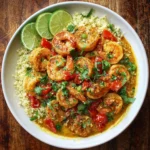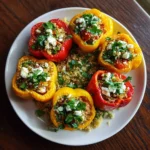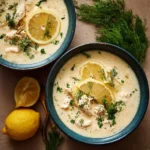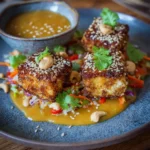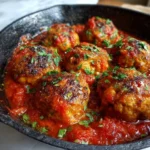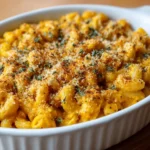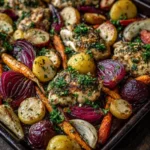Spicy Coconut Curry Shrimp over Cauliflower Rice
The History
The roots of Spicy Coconut Curry Shrimp can be traced back to the rich culinary traditions of Southeast Asia, where coconut milk and aromatic spices have long been staples in curries. Countries like Thailand, Indonesia, Malaysia, and Sri Lanka have each developed their own unique variations of coconut-based seafood curries, blending local herbs, chilies, and tropical flavors. These dishes traditionally emerged from coastal communities that relied on fresh seafood and abundant coconut palms.
Over time, this style of cooking spread globally through trade, migration, and cultural exchange. In recent decades, health-conscious food lovers in Western countries began adapting traditional recipes to suit low-carb, gluten-free, or paleo diets—leading to innovations such as serving curry over cauliflower rice instead of jasmine or basmati rice. This modern twist preserves the bold, creamy essence of the original dish while making it more accessible to those managing blood sugar levels or seeking lighter alternatives.
Today, Spiny Coconut Curry Shrimp over Cauliflower Rice stands at the intersection of tradition and innovation—a celebration of global flavors with a contemporary wellness spin. It reflects not only centuries of culinary evolution but also the adaptability of comfort food in a modern kitchen.
Ingredients Breakdown
For the Spicy Coconut Curry Sauce:
- Coconut Milk (Full-Fat): Provides a rich, creamy base and balances the heat from the spices. Full-fat is recommended for maximum flavor and texture.
- Red Curry Paste: A complex blend of red chilies, garlic, lemongrass, galangal, shrimp paste, and spices. It’s the heart of the dish’s heat and depth.
- Fresh Ginger: Adds warmth and zesty brightness; enhances digestion and complements the spice profile.
- Garlic: Offers pungent aroma and savory depth when sautéed into the sauce.
- Lemongrass (optional but recommended): Imparts a citrusy, floral note characteristic of Thai cuisine. Bruise the stalk before adding to release essential oils.
- Fish Sauce: Contributes umami and saltiness without overpowering; a cornerstone of Southeast Asian seasoning.
- Lime Juice: Brightens the entire dish and cuts through the richness of the coconut milk.
- Brown Sugar or Coconut Sugar (optional): A small amount helps balance acidity and spice, enhancing overall complexity.
- Vegetable or Chicken Broth: Thins the sauce slightly and adds savory body if you prefer a looser consistency.
For the Shrimp:
- Raw Shrimp (peeled and deveined): Medium to large-sized shrimp work best. Fresh or high-quality frozen shrimp are ideal. They cook quickly and absorb the curry flavors beautifully.
- Paprika or Smoked Paprika: For color and subtle smokiness.
- Salt and Black Pepper: Essential seasonings to enhance natural flavors.
For the Cauliflower Rice:
- Raw Cauliflower (or pre-riced): The base for our grain-free alternative. When pulsed finely, it mimics the texture of cooked rice.
- Olive Oil or Coconut Oil: Used for sautéing; coconut oil complements the tropical flavor theme.
- Onion (finely diced): Builds foundational flavor when caramelized lightly.
- Garlic (minced): Enhances the savory component of the rice substitute.
- Turmeric (optional): Adds golden color and mild earthy flavor with anti-inflammatory benefits.
- Salt and Pepper: To taste.
Garnishes and Toppings:
- Fresh Cilantro: Adds herbal freshness and vibrant color.
- Sliced Green Onions: Provide a mild onion bite and visual appeal.
- Lime Wedges: Serve on the side for an extra burst of acidity.
- Chopped Roasted Peanuts or Cashews: Offer crunch and nutty contrast.
- Thai Basil or Regular Basil: Optional herbaceous accent with sweet-anise notes.
- Red Chili Slices: For added heat and presentation.
Step-by-Step Recipe
Preparing the Cauliflower Rice
- Remove leaves and stem from 1 medium head of cauliflower. Chop the florets into chunks that will fit your food processor.
- Pulse the cauliflower in batches until it reaches a rice-like consistency—be careful not to over-process into mush.
- Heat 1 tablespoon of coconut oil in a large skillet over medium heat. Add ¼ cup finely diced onion and sauté for 3–4 minutes until translucent.
- Add 2 minced garlic cloves and cook for another 30 seconds until fragrant.
- Stir in the riced cauliflower, about ½ teaspoon salt, black pepper, and a pinch of turmeric (if using). Cook for 6–8 minutes, stirring occasionally, until tender but not soggy.
- Cover and keep warm while preparing the curry. Do not overcook, as it may become watery.
Preparing the Spicy Coconut Curry Shrimp
- In a large non-stick or cast-iron pan, heat 1 tablespoon of coconut oil over medium heat.
- Add 1 tablespoon of grated fresh ginger and 3 minced garlic cloves. Sauté for 30 seconds until aromatic.
- If using lemongrass, bruise one stalk by smashing it with the back of your knife and add it whole to infuse the oil. Remove before serving.
- Stir in 2–3 tablespoons of red curry paste (adjust to desired spiciness) and toast for 1 minute to unlock its essential oils and deepen the flavor.
- Pour in 1 can (13.5 oz) of full-fat coconut milk. Whisk well to combine with the curry paste.
- Bring the mixture to a gentle simmer. Stir in 1 tablespoon fish sauce, juice of half a lime, and 1 teaspoon coconut sugar (optional).
- If needed, add ¼ cup of vegetable broth to thin the sauce slightly.
- Let the sauce simmer uncovered for 8–10 minutes, allowing the flavors to meld and the sauce to thicken slightly.
- While the sauce simmers, pat dry 1 pound of raw shrimp and season lightly with paprika, salt, and pepper.
- Add the shrimp to the simmering curry sauce. Stir gently and cook for 3–4 minutes, flipping halfway, until the shrimp turn pink and opaque. Avoid overcooking to maintain tenderness.
- Once cooked, remove the lemongrass stalk (if used), taste, and adjust seasoning with more lime juice, fish sauce, or sugar as needed.
Assembling the Dish
- Spoon a generous portion of hot cauliflower rice onto each plate or bowl.
- Ladle the spicy coconut curry shrimp and sauce over the top.
- Garnish with chopped cilantro, sliced green onions, crushed peanuts, chili slices, and serve with lime wedges on the side.
Tips
- Don’t Overcook the Shrimp: Shrimp cook very quickly. Remove them from heat as soon as they turn pink and curl into a “C” shape. Overcooked shrimp become rubbery.
- Toasting the Curry Paste: Toasting the red curry paste in oil before adding liquids enhances its flavor dramatically—don’t skip this step.
- Use Full-Fat Coconut Milk: Light coconut milk tends to separate and lacks the luxurious mouthfeel necessary for authentic texture.
- Control the Heat: Start with 2 tablespoons of red curry paste and add more after tasting. You can always increase the spice level, but you can’t reduce it.
- Prep Ahead: You can make the cauliflower rice and even the curry base (without shrimp) a day ahead. Reheat gently and add fresh shrimp just before serving.
- Dry Your Shrimp: Patting the shrimp dry ensures better searing and prevents the curry from becoming watery.
- Acid is Key: Finish with a squeeze of fresh lime juice right before serving—it lifts all the flavors and brings balance.
- Avoid Boiling the Coconut Milk: High heat can cause coconut milk to separate. Keep the sauce at a gentle simmer.
- Make It Creamier: For an even richer sauce, stir in 1–2 teaspoons of coconut cream at the end.
- Texture Tip: If your cauliflower rice releases water during storage, drain it in a colander and press gently before reheating.
Variations and Customizations
Protein Swaps:
Replace shrimp with chicken breast strips, scallops, firm tofu, or white fish fillets like cod or halibut. Adjust cooking times accordingly.
Vegetarian/Vegan Version:
Omit shrimp entirely and use chickpeas, lentils, or tempeh. Substitute fish sauce with soy sauce or tamari (for gluten-free) and ensure your curry paste is vegan-friendly (some contain shrimp paste).
Low-Sodium Option:
Use reduced-sodium coconut milk and omit fish sauce or replace with a splash of lemon juice and a dash of seaweed flakes for umami.
Keto-Friendly Tweaks:
This dish is naturally low-carb, but to stay strictly keto, avoid sugar entirely and confirm your curry paste has no added sugars.
Extra Veggies:
Add bell peppers, spinach, zucchini noodles, broccoli florets, or snap peas during the last few minutes of cooking for added nutrition and color.
Milder Flavor Profile:
Swap red curry paste for yellow or green curry paste, which are typically less spicy. Alternatively, dilute the heat with extra coconut milk and a spoonful of plain yogurt (not dairy-free).
Thai-Inspired Fusion:
Add kaffir lime leaves, Thai basil, and a splash of tamarind paste for a more authentic Thai street food experience.
Creamier Texture:
Blend part of the coconut curry sauce before adding the shrimp for a silkier, restaurant-style consistency.
Meal Prep Friendly:
Portion into airtight containers and refrigerate for up to 3 days. Freeze the curry (without garnishes) for up to 2 months. Reheat gently on the stove with a splash of broth.
Health Considerations and Nutritional Value
Spicy Coconut Curry Shrimp over Cauliflower Rice is a nutrient-dense meal that aligns well with various dietary lifestyles including low-carb, keto, paleo, gluten-free, and dairy-free regimens.
Nutritional Highlights:
- Shrimp: Low in calories and high in protein, shrimp provide essential nutrients like selenium, vitamin B12, iodine, and omega-3 fatty acids, supporting brain and thyroid health.
- Coconut Milk: Though high in saturated fat, it contains medium-chain triglycerides (MCTs), which are metabolized differently than long-chain fats and may support energy and metabolism. Moderation is key.
- Cauliflower Rice: A fantastic low-calorie, low-carb substitute for grains. Rich in fiber, vitamins C and K, and antioxidants like glucosinolates, which may support detoxification pathways.
- Garlic & Ginger: Possess anti-inflammatory, antimicrobial, and immune-boosting properties.
- Red Curry Paste Ingredients: Chilies contain capsaicin, known to boost metabolism and provide pain relief in some studies.
Caloric Estimate (per serving, serves 4):
- Calories: ~320–360
- Protein: ~25g
- Fat: ~22g (mostly healthy fats from coconut)
- Carbohydrates: ~10g
- Fiber: ~4g
- Sugar: ~5g (naturally occurring)
Considerations:
- Sodium: Store-bought curry pastes and fish sauce can be high in sodium. Opt for low-sodium versions or make your own curry paste when possible.
- Allergies: Contains shellfish (shrimp) and tree nuts (coconut). Use caution for those with allergies. Note: While coconut is classified as a tree nut by the FDA, most people with nut allergies can safely consume coconut.
- Pregnancy: Fully cooked shrimp is safe during pregnancy and provides vital protein and DHA. Ensure seafood is sourced responsibly to minimize mercury exposure.
- Heart Health: Despite coconut milk’s saturated fat content, emerging research suggests it may not negatively impact cholesterol in the same way as animal-based saturated fats—but should still be consumed mindfully.
Ingredients
For the Cauliflower Rice:
- 1 medium head cauliflower (or 4 cups riced cauliflower)
- 1 tbsp coconut oil or olive oil
- ¼ cup finely diced onion
- 2 cloves garlic, minced
- ¼ tsp turmeric (optional)
- Salt and black pepper to taste
For the Spicy Coconut Curry Shrimp:
- 1 lb raw shrimp, peeled and deveined
- 1 tbsp coconut oil
- 1 tbsp fresh ginger, grated
- 3 cloves garlic, minced
- 1 stalk lemongrass (optional, bruised)
- 2–3 tbsp red curry paste (to taste)
- 1 can (13.5 oz) full-fat coconut milk
- 1 tbsp fish sauce (or soy sauce/tamari for vegetarian option)
- Juice of ½ lime
- 1 tsp coconut sugar (optional)
- ¼ cup vegetable or chicken broth (optional)
- Paprika, salt, and pepper for seasoning shrimp
Garnishes:
- Fresh cilantro, chopped
- Sliced green onions
- Crushed roasted peanuts or cashews
- Lime wedges
- Thinly sliced red chili (optional)
- Thai or regular basil leaves
Directions
- Prepare the cauliflower rice by processing florets in a food processor until rice-sized. Set aside.
- Heat coconut oil in a large skillet over medium heat. Sauté onion until soft (3–4 mins). Add garlic and cook 30 seconds.
- Add riced cauliflower, turmeric (if using), salt, and pepper. Cook 6–8 minutes, stirring occasionally. Cover and set aside.
- In another large pan, heat 1 tbsp coconut oil over medium heat. Add ginger, garlic, and lemongrass (if using). Sauté 1 minute.
- Stir in red curry paste and toast for 1 minute until fragrant.
- Pour in coconut milk, whisking to combine. Bring to a gentle simmer.
- Add fish sauce, lime juice, sugar, and broth (if using). Simmer 8–10 minutes to thicken slightly.
- Season shrimp with paprika, salt, and pepper. Add to curry sauce and cook 3–4 minutes until pink and opaque.
- Remove lemongrass. Taste and adjust seasoning with more lime, salt, or fish sauce.
- Distribute cauliflower rice among bowls. Top with curry shrimp and sauce.
- Garnish generously with cilantro, green onions, peanuts, chili, and serve with lime wedges.
FAQ
Can I use frozen shrimp?
Yes, frozen shrimp work perfectly. Thaw them in cold water, pat dry thoroughly, and proceed with the recipe.
Is this dish spicy?
It can be! The level of heat depends on the brand and quantity of red curry paste used. Start with 2 tablespoons and add more after tasting.
Can I make this ahead of time?
Yes, the curry base (without shrimp) and cauliflower rice can be made 1–2 days in advance. Reheat the sauce, add raw shrimp, and cook just before serving for best texture.
What can I substitute for fish sauce?
Soy sauce, tamari (gluten-free), or coconut aminos are good substitutes. For a vegan umami kick, try a mix of miso paste and seaweed.
Can I use canned coconut milk from a carton?
No—those are usually “coconut beverage” or light versions meant for drinking. Use canned full-fat coconut milk for proper richness and consistency.
How do I prevent cauliflower rice from getting soggy?
Avoid overcooking, don’t cover while cooking unless resting, and consider squeezing out excess moisture after cooking if needed.
Can I freeze this dish?
Yes, but freeze only the curry (without garnishes). Shrimp may become slightly softer upon thawing, but flavor remains excellent. Thaw in fridge overnight and reheat gently.
Is this recipe Whole30 compliant?
Yes, if you use a compliant red curry paste (no sugar or additives), omit sugar, and use coconut aminos instead of fish sauce (if strict).
Can I bake the shrimp instead of sautéing?
Yes. Toss seasoned shrimp with oil and roast at 400°F (200°C) for 8–10 minutes, then add to finished curry.
Why did my coconut milk separate?
High heat or prolonged boiling can cause separation. Always keep the sauce at a gentle simmer and stir frequently.
Summary
Spicy Coconut Curry Shrimp over Cauliflower Rice is a vibrant, flavorful dish that blends Southeast Asian aromatics with modern healthy eating trends. Packed with protein, healthy fats, and fiber, it’s both satisfying and nutritious.
This easy-to-customize recipe offers bold taste in every bite—creamy coconut sauce, plump shrimp, and fluffy cauliflower rice come together in under 30 minutes for a restaurant-quality meal at home.
